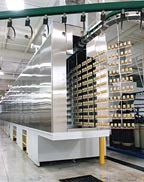
If a part is not thoroughly cleaned, there will be a negative impact downstream. Cleaning and phosphatizing pretreatment solutions should aim to maximize productivity and enhance performance while minimizing environmental impact and cost.
The first step in the cleaning operation is to determine when a surface is considered "clean." Gen-erally, a surface is considered clean when it is ready for the next process. The degree of cleanliness required must also be financially appropriate. More time, effort and money will be required for certain parts or products than others.
It is helpful to identify the level of cleaning your parts need using a simple 1-to-10 scale, 10 being the highest. The more critical the final performance specification, the higher the number should be. As an "industry standard," a 6 to 8 on the relative scale is achievable by most and can offer solid quality results.
Measurement methods
Visual inspection: Though not particularly accurate quantitatively, this method should not be overlooked. If a product doesn't look clean, it probably isn't.White glove test: This is a qualitative test used to assist visual inspection. The test is performed by simply wiping a part with a white cloth or paper towel after it has been cleaned and checked for residue. The white glove procedure is good for determining the presence of inorganic and particulate matter, such as carbon smut, that often does not show up until substrates are cleaned.
Water-break test: This is primarily a test for the presence of petroleum-based soils such as oil and grease. The processed part is dipped or sprayed with water, and the manner in which the water "sheets off" is inspected. If a uniform film of water is observed-there's no beading-it is considered water-break-free, or clean of organics.
Scotch tape test: Another qualitative test aimed at determining if soils remain on a part after cleaning is the Scotch tape test. Clear adhesive tape is laid on a part and rubbed firmly over the surface. This test shows how much soil, such as carbon smut and weld smoke, has adhered to the part.
Residue testing: Unlike the previous methods, this cleanliness evaluation is quantitative. Residue testing normally involves a solvent extraction, or boil-out, of the test piece with an organic solvent, followed by evaporation of the solvent. Once the solvent has been flashed, the remaining residue from the part is carefully and accurately weighed. Residues are normally expressed in terms of milligrams per square meter of surface area.

Cleaner selection
There are three issues that must be addressed prior to selecting a cleaning product: the quality of the water supply, cost and environmental impact.Whether drawing from a well or tapping into a municipal water supply, the kind of water used can impact chemical performance and finished goods quality. Some common constituents of water that should be managed are hardness, iron, silica and bacteria.
The inverse solubility of calcium and magnesium ions, particularly in the presence of carbonates, can lead to problems such as scale buildup. This is especially troublesome around heat exchange surfaces where small layers of scale can increase energy consumption dramatically.
Spotting of parts can be a problem in areas where the water is very hard. Some detergents can be rendered useless by reacting with hardness rather than with the soil for which it was intended. Controlling hardness can be accomplished mechanically and chemically. Mechanical methods include water softening (ion exchange) or deionizing (dissolved solids removal). Both of these methods have pros and cons, but one thing in common: they require capital equipment. This makes cost justification important.
Typically, these methods enhance quality and reduce energy consumption and chemical use. Chemically, water hardness can be "tied-up" by treating these ions with a more soluble agent, such as certain phosphates. Also, holding these metals in a soluble state with chelating agents will render them harmless.
Iron, which is often found in well waters, can stain various substrates. Also, deposits of iron can create corrosion cells on equipment and act as seed points for failure due to corrosion under paint films. Ultrafiltration, chelating and precipitation pretreatments are ways to deal with iron.
High levels of silica, either from incoming water or the products used, can cause very serious problems. Because of the tenacious nature of silica scales, this glass-like film, if developed, robs systems of heat transfer efficiency and requires aggressive chemical and/or mechanical removal once found. Filming on parts, especially glass and plastic, may interfere with subsequent processing of parts or their finished quality.
High bacteria levels can be present in any water supply. They can cause rapid slime growth in tanks and raise the level of dissolved solids in solution. This can cause contamination, which can show up as corrosion under paint and increased levels of foaming. Iron-reducing bacteria can cause the process equipment to deteriorate.
If a well is used and bacteria levels are beyond the acceptable range, the water will need to be pretreated. If a cleaning solution or rinse has gone bad due to bacteria growth, the equipment should be thoroughly cleaned, sanitized and rinsed before being put back on line.
People often believe that less-expensive products are more economical. Realistically, the objective is to achieve an adequately clean surface at the lowest possible "overall process" cost. Process cost is a function of the following:
- price per gallon
- use concentration
- labor cost
- freight cost
- energy cost
- disposal cost
- administrative costs
Environmental concerns
Regulations relating to product constituents and reporting, effluent and emissions restrictions, and the high cost of disposal of spent solutions are a fact of life for manufacturers using industrial chemicals. The only effective way to deal with the environmental puzzle is to evaluate product and process options with vendors that can help with pollution prevention, resource conservation, waste minimization and human health and safety.Vendors should have a fully staffed department with easy-to-reach experts who are available to help with routine information, such as material safety data sheet (MSDS) explanations and emergency response.
It is the user's responsibility to be familiar with the potential damages from using pretreatment products and to train operators in their safe use. Vendors should be available to assist in training personnel in this area.
Industrial chemicals can be dangerous. Exercise caution and follow all appropriate safety procedures when handling these products. OSHA MSDSs should be readily available and completely filled out.
Because products are handled on a day-to-day basis, it is imperative to practice accident prevention. When possible, consider automated methods of feeding and monitoring concentrated chemicals and their solutions to minimize user contact. Also, packaging that offers the least exposure/ contact should be investigated.
As a user of industrial products, labeling is critical for several reasons, including product identification and warning statements. This is the first line of defense on the floor. Another reason that is gaining importance is compliance with worker right-to-know laws. Comprehensive labels clearly depicting the product and its effects should be part and parcel of every cleaning program.

Controlling the process
In a pretreatment system there are, realistically, only four factors over which you have direct control: time, temperature, force and concentration. Usually, one of these factors can be looked to for problem resolution or process enhancements.Regarding time, the longer a soil and substrate are in contact with the chemical solution, whether for cleaning or conversion purposes, the more reaction there will be. The control of contact time is usually equipment oriented. The method of application may allow relative flexibility, as in the case of most immersion systems and nonrecirculating spray-type systems, or be somewhat fixed, like typical recirculating spray washers. Ways to increase or decrease contact time include changing process time through line speed or dip time manipulations, adding or deleting stages to the application and employing more or fewer risers within a stage.
As a rule of thumb, pretreatment chemical processes can be accomplished quicker with higher temperatures. Certain substrate and chemical compounds are adversely affected by elevated temperatures. Some foaming problems are temperature-related, as in the case of cleaners built with nonionic surfactants. Proper temperature management involves maintaining thermostats and heating sources, including boilers, heating elements and burners.
Forms of force include agitation, impingement, pressure or any method that physically moves chemical solutions in contact with soils and substrates. Force can come from several sources, including pressure sprayers, nozzles, air lances, "elbow grease," and electrical or sonic energy. This factor is extremely important in removing tough soils, such as particulate matter and heavy buildups of grease and oil.
Controlling force in a system depends on the application used. In the case of spray systems (recirculating or nonrecirculating), the key is to maintain product flow by keeping nozzle orifices clear of scale and shop debris. Typical immersion systems, or dip tanks, can be upgraded to improve this factor by either air sparging the tank or recirculating the solution within the tank via a pump or mixer blade.
Regarding concentration, it's often heard that, "If a little does a good job, more will do better." This is not necessarily so. In fact, problems associated with rinsing, carryover and the quality of finished goods may be the result of this thinking. The type of substrate, the soil present and the equipment used influence chemical selection and appropriate solution strengths.
For example, products are often designed to work within a temperature range. Operating outside the correct range may lead to either a lack of cleaning or foaming. Certain blends of chemicals are designed for immersion systems, and when used in another method of application, there may be problems with the degree of reaction (cleaning or phosphatizing) flash rusting or, again, foaming. It is clear that concentration control is very important.
At a minimum, pretreatment solutions should be monitored regularly. Simple titrations are typical, using either dropper or burette techniques. In the case of phosphate solutions, pH is also critical to success and should be watched using an analogue or digital meter.
Figure 1 is a reference guide to the interrelationship between the main four factors controlling the pretreatment process. By adjusting one factor, the others will be affected. The trick in managing pretreatment chemical solutions is to learn how to maneuver those controls efficiently and effectively without unwanted results. Once this is accomplished, system upsets are easily dealt with.
Managing pretreatment chemical solutions is an extremely important part of the overall manufacturing process. By recognizing the relationship among the substrate, soil, method of application and appropriate chemical solutions, companies can take a planned approach to managing results and preventing potential problems.



